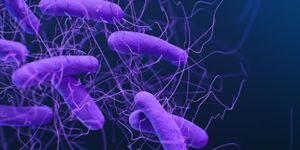Malevolent Creativity: How our brains silence empathy to craft harmful plans
What's worse than someone with evil intentions? Someone who's good at it.
Malevolent behavior is an unfortunate and unpredictable facet of human nature, with far-reaching negative implications for society. Adding creativity to malicious intent amplifies the success rate as strategic subterfuge, enabling perpetrators to evade detection and punishment.
However, the biological origins of such malevolent schemes remain a mystery. Understanding the neurological underpinnings of malevolent creativity (MC) could prevent the escalation of these behaviors and mitigate their impact on society. Scientists, led by Qiao and their team at Wenzhou Medical University, scanned the brain's surface to discover the roots of malicious planning. What they found was a network of brain regions that act as bullies to silence our better nature.
by Marco Verch Flixr
Previous research has linked MC to lower emotional intelligence and the "dark triad" of personality traits—psychopathy, Machiavellianism, and narcissism. The dark triad's components are distinct, though they share some common features, such as a proclivity to victimize others. In real life, traits such as psychopathy and Machiavellianism manifest in a less empathic view of the world, such as an exceptional ability to identify potential assault victims through subtle physical cues. Narcissists think of themselves as greater than their true abilities would suggest and consistently shun responsibility for failures.
Scientists have gained insight into the evil side of human nature by influencing the activity of specific brain regions while people dream up harmful plots. In one study by Gao et al., about 90 young adults were tasked to create ways to destroy a classmate's coat or set up a shy friend with their crush without their knowing, all the while receiving electric current to their brain. By applying this transcranial direct current stimulation (tDCS) the researchers found they could significantly alter creative thinking and emotional regulation.
Located above your ear and toward the brain's center, the posterior cingulate gyrus (PCG) is a crucial region responsible for morality. Gao et al. found that disrupting PCG activity increased MC's originality and fluency. Its activity significantly affected the recognition of emotions on faces and regulating emotions when exposed to emotionally charged images like aggressive dogs or unsanitary toilets. While the results of this research were mixed, it led other scientists, such as Qiao's group, to hone in on the brain regions that shape morality.
Participants in the newest Qiao et al. study were tasked to generate malevolent solutions to everyday problems during a functional near-infrared spectroscopy (fNIRS) brain scan. The researchers went beyond previous work by examining brain activity not just during the generation of plans to cause physical harm but plans to lie and play tricks. Examples of the tasks presented to participants included making the injury of an athletic rival appear accidental or devising pranks against a strict teacher. While these forms of malintent shared some neural responses, specialized interactions were necessary to generate the cruelest solutions. The researchers also evaluated participants' personality, general creativity, and dark triad traits.
Qiao et al. found MC requires a complex web of brain connections. Across the board, hurtful scheming required regions associated with creativity and problem-solving within the prefrontal cortex (PFC) and temporal lobe.
When the PCG and other regions associated with prosocial behavior (rSMG, MOG) were largely left out of the creative loop, more deceitful plots were imagined. Interestingly, during MC, brain areas that regulate attention were highly active and connected to these morality areas. As attention area activity increased, moral regions got quiet, and MC improved. It's as if the attention areas silenced empathetic impulses to allow egocentric and selfish thinking to flourish.
What about specific types of evil? For the best lies, you'll need theory of mind, which is believed to originate at the most frontal tip of the brain's two hemispheres—the frontal poles. Theory of mind is the ability to interpret how others see the world. Qiao et al. discovered a link between higher activity in the frontal poles and more persuasive lies. So, when the goal is to manipulate a potential victim with lies, it's essential to keep their point of view in mind.
by Marco Verch Flixr
A keen sense of dark humor can help you lampoon your target when designing a prank or trick. The perfect synergy of brain activity for pranks involves humor areas (right superior temporal gyrus and lIFG), while avoiding input of empathetic regions (rDLPFC and rSMG). These connections allowed one to design selfish MTV-worthy tricks without being distracted by a silly concern for others.
Finally, when thinking of hurting others, it's easiest when you can avoid considering the victim's negative experience. To generate violent plots, the region responsible for distinguishing yourself from others (rIPL) must have a poor connection with a specific moral area (rDLPFC). This disconnect unleashes truly selfish intentions.
These findings demonstrate that the human brain actively manages and limits the input from areas associated with empathy and consideration for others when tasked with devising dirty deeds. The mind can freely generate a harmful plan or a creative ruse by inhibiting these moral centers.
Specific brain connections can predict an individual's ability to generate ill intent. The strength of these connections and regional activity often correlated with MC creativity, dark triad traits, moral identity, and overall creativity level. While the study's fNIRS brain scanning method offers valuable surface-level insights, further research probing deeper brain regions is warranted to detect how human morality is undermined.
Understanding these neural patterns may pave the way for interventions aimed at curbing malevolent behavior and promoting empathy, leading to enhanced counseling, behavior management, and prevention strategies.
Before we cancel all the creative writing courses in prisons, empathy training programs demonstrate significant success at increasing the ability to sense and understand the experiences and mental states of others. Several professions utilize these programs in the healthcare field. However, empathy training relies on the participant's desire to improve. Perhaps learning to match the emotional state of others is too much to ask of adults with established dark triad traits.
Prevention might be more feasible than rehabilitation. The work of Qiao et al. and other neuroimaging studies could provide clinicians with the ability to identify and intervene when children or young people display immoral behaviors. One treatment strategy could be biofeedback, in which participants view real-time displays of these important morality-associated networks and put in mental effort to strengthen their interactions.
The implications for public protection underscore the critical need to address malevolent creativity. Thanks to this work, empathy-focused interventions can now be examined through neuroimaging techniques.
Sources: eNeuro, Social Cognitive and Affective Neuroscience, Journal of Research in Personality, Personality and Individual Differences, Journal of Counseling Psychology, Nature Reviews










